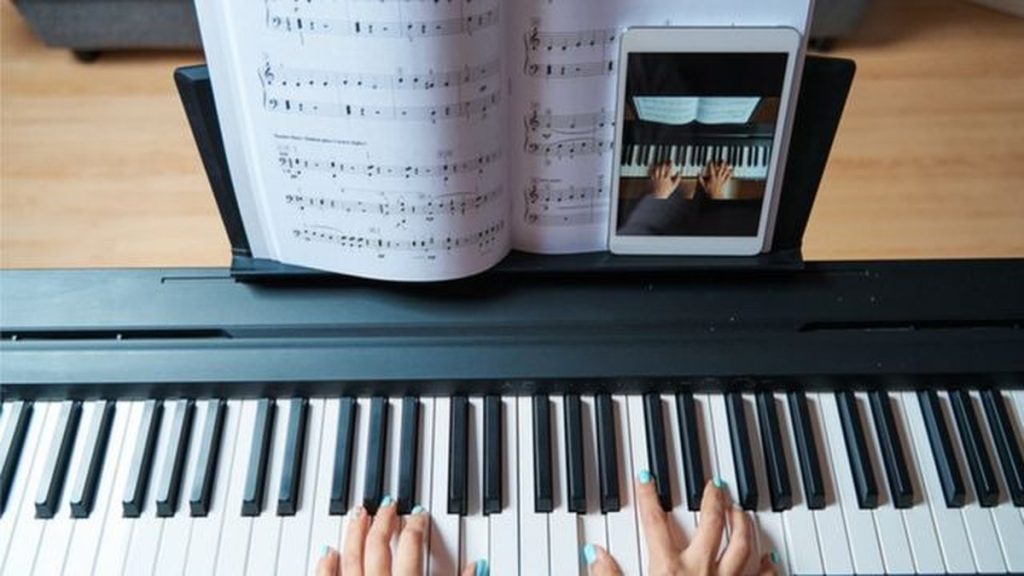To learn something new, you have to practice, practice, rehearse, common sense says – “Practice makes perfect.”
- Are you talented? The organization runs 15 cities in the country looking for smart new Brazilians
But a number of scientific studies have suggested that consistent practice may not be the most effective way to learn a new skill: The brain needs to consolidate the newly acquired knowledge and transform it from a fleeting memory to a permanent one.
And one of the most recent discoveries is that Small breaks with activity lead to big learning gains: The brain makes use of these pauses to perform a super-fast mental “replay” of what it has just learned, reinforcing the newly acquired skill.
These short breaks can be especially productive for the brain of those who practice new, precise and repetitive movements, such as athletes or musicians – or even patients trying to regain skills they lost after a stroke (see later in the article).
“Imagine a scenario in which someone starts learning to play a new song on the piano. We found that during pauses, the brain would repeat a 50 times faster copy of the movements used to play the song, over and over again, strengthening the connection of neurons in areas associated with that new memory ”, explains to BBC News Brazil Brazilian researcher Leonardo Claudino, one of the co-authors of a study on the topic conducted by the US National Institutes of Health (NIH). Published 2021 in Cell Reports.
During moments of rest, the brain is thought to be able to relay memories to areas of the brain where they will be combined – Image: Getty Images via BBC
In that study, he and other National Institutes of Health researchers recorded the brain activity of 33 right-handed volunteers as they learned to type a series of numbers with their left hand on a keyboard. The volunteers had to write as many sequences as possible for ten seconds, then take a ten-second break.
Some members of this same research team, led by scientist Marilyn Bonstrup, had already observed in previous studies that after brief periods, volunteers improved the speed and accuracy of typing numerical sequences of this type.
Now, the goal was to understand what happens in the brain in the process. Using MEG tests, the scientists were able to observe the rapid “replay” that the brain made of what it had just learned.
“And we discovered that[merging]is happening on a much faster time scale than previously thought,” notes Leonardo Claudino. “A two-second skill happens to be repeated in the brain on a millisecond scale.”
By doing this “replay,” the brain then consolidates the learning.
The memory pathway in the brain
The same idea applies to athletes training a new movement: in pauses the brain consolidates learning of this skill – Image: Getty Images via BBC
Even before studying the effect of these small pauses, scientists already knew that the brain needs rest to consolidate memories – in practice, according to scientific knowledge so far, this involves transferring memory from the hippocampus, where temporary records are kept, to areas of the neocortex, Where there is long-lasting memory.
But until these recent discoveries, this consolidation process was thought to occur only during sleep – when the brain is most devoid of external sensory input.
With the new studies, Claudino points out, it is possible to recognize that memories are also incorporated nearly synchronously with practice — a process that appears to be complementary to what happens during sleep.
But this is something that still needs to be confirmed by further research.
“Not much is known yet, and they are certainly[pauses]physiologically different. (…) But perhaps sleep encodes a more complete experience—the full context (of that memory), who was there, and what the environment was like. A rapid pause might register More subtle details: the synergy of the fingers when writing, the movement. It’s a hypothesis for someone to investigate in the future”, ponders Leonardo Claudino.
How, then, can we make practical use of the scientific knowledge accumulated thus far?
“I see more direct use when I think of sports practices or musical performance, which include sessions in which the athlete or artist performs the same movement multiple times,” Claudino explains.
“One of the lessons to take away is this: When you start learning a new technique, avoid training to exhaustion, to failure. Instead, it is better to take breaks. Perfection will come more quickly if you give yourself time. Instead of endless training to achieve perfection.”
“We usually learn a new technique by repeating it over and over – you repeat it and iterate it, and there will come a time when you already know the sequence of movements that will produce the final activity. The idea is that, instead of training it to exhaustion, do it, say, ten times, then take a break, and repeat it again.“
The same reasoning can also guide pedagogical practices in schools or universities.
“In a teaching environment, perhaps the teacher, when introducing a fundamentally new concept, can think of the learning session as including these rest periods. It is important that the student has these breaks, because his brain will be active, despite the rest – this is our finding Its hippocampus and cortex will conduct these exchanges, which will enhance modern learning,” explained the researcher.
What is not yet known for certain is the optimal duration of rest for optimal consolidation of new learning.
“This is one of the challenges of practicality,” Claudino says, remembering that this can also depend on the type of skill acquired and the individual characteristics of each practitioner.
But in the National Institutes of Health studies, those in which volunteers typed sequences on a keyboard, the researchers noted that learning gain was greater when the training and rest periods were similar. For example, ten minutes of training and ten minutes of rest.
However, Claudino points out that these are controlled studies conducted in the lab, so their conclusions don’t necessarily translate into real life.
How to take a productive break for the brain?
Likewise, the fact that experiments are conducted in fully controlled environments makes it difficult to get a “cake recipe” for the kind of pauses most effective for helping the brain learn.
In the case of laboratory studies, during the rest period, each volunteer stood without writing at the computer.
In real life, the researcher suggests giving the brain a rest from what it is learning.
“If someone is learning to play a song, I imagine[pausing]would simply be to stop playing, think about something else, or not do another activity that might conflict with that song — for example, don’t try to learn another song while you Rested. From the first, because you use the same areas and abilities,” he explains.
Other lines of research have also contributed to the science of learning – and provided complementary conclusions that can help advance knowledge.
In an interview with BBC News Brazil in 2020, cognitive psychology researcher Barbara Oakley, author of Learning to Learn, explained that the brain works in two different, complementary ways in learning: focused mode (when we pay attention to an exercise, movie, or teacher, For example) and diffuse mode (when the brain is relaxed).
According to Oakley, the brain needs to switch between diffuse and focused mode to learn effectively. Thus, relaxing the mind – whether it’s going for a walk or changing activities – directly helps improve learning and problem-solving.
Oakley suggested “When you’re stuck on a math assignment, the best thing to do is change your focus and study some geography. That way you’ll be able to move forward when you get back to math.”
Going back to Leonardo Claudino’s research, one area of focus in studying memory enhancement during short breaks is helping people recover their skills after a stroke. This could happen, in the future, to improve rehabilitation sessions as much as possible.
“We now have a biomarker that shows when and where the brain is working to consolidate ability,” the scientist explains. “We could consider developing a monitoring system while a person is undergoing occupational therapy, neurostimulation or a neuromodulation technique, (…) and having the system maximize skill repetition.”
This optimal brain stimulation can make rehabilitation produce faster results, Claudino says.
“Our results suggest that it may be important to improve the timing and composition of rest periods when implementing rehabilitation therapies for stroke patients or when learning to play the piano among lay volunteers.” The laboratory responsible for this research is at the National Institutes of Health.
And Leonardo Claudino adds: They are, at the moment, areas of research that are still open. The important thing is to understand that even during rest, the brain does not stop learning.
“What goes against common sense is that when you’re still, your brain is still. We still understand this phenomenon, but (in these pauses) you occupy your brain with less processing of stimuli and production of movement. Then this window gives it a chance to solidify what it’s already learning” .

“Hardcore beer fanatic. Falls down a lot. Professional coffee fan. Music ninja.”

:strip_icc()/i.s3.glbimg.com/v1/AUTH_fde5cd494fb04473a83fa5fd57ad4542/internal_photos/bs/2024/g/0/V5FYuBQliYVGYOkMB4Aw/thumbnail-amanda.jpg)
:strip_icc()/i.s3.glbimg.com/v1/AUTH_bc8228b6673f488aa253bbcb03c80ec5/internal_photos/bs/2024/0/U/jdfG7pTzAeh6r1IrHVSA/2024-04-27t130959z-884244187-up1ek4r10klaz-rtrmadp-3-soccer-england-whu-liv-report.jpg)
:strip_icc()/i.s3.glbimg.com/v1/AUTH_59edd422c0c84a879bd37670ae4f538a/internal_photos/bs/2023/E/W/8PPh4iSA2xesn8mdBiSg/praca-relogio-106-17-foto-cecilia-bastos-17.jpg)



More Stories
Brazilian scientist wins disputed Marie Curie research grant | Sciences
The European Space Agency's probe detects “spiders” on Mars Sciences
UFRJ is Africa's Ambassador for Science – Conexão UFRJ